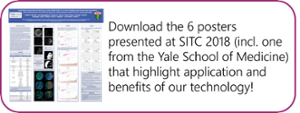
Multiplex IHC staining and analysis in a single work day
Conventional immunohistochemistry (IHC) methods only provide insight into a limited number of markers of interest, prompting the need for development of multiplexed methods to assess and characterize multiple cell phenotypes and their spatial context in a single tissue sample.
Until recently, there has been a trade-off between technology platforms that enable high multiplexing for the detection of many biomarkers and those that preserve the morphology of the sample. Ultivue's UltiMapper™ I/O kits using InSituPlex® staining technology for highly multiplexed in situ imaging bridge this technology gap, enabling high-content tissue analysis while providing an integrated workflow using conventional autostainers, imaging scanners, and analysis software. This seamless integration to existing histology workflows enables users to go from staining to analysis within the same day.
The InSituPlex DNA-barcoding and antibody staining technology is what drives this accelerated workflow to enable so many benefits for multiplex IHC:
- High Multiplexing In Situ: High number of markers with whole slide imaging
- Sample Fully Preserved: Complete retention of sample antigenicity
- Plug-in Implementation: Validated on multiple tissue types, using widely available fluorescence microscopes
- Improved Workflow: Single staining and simultaneous amplification for all markers lowers sample-to-answer time
- Versatile Implementation: Same technology, same reagents from research to clinic: equally applicable from discovery to downstream high throughput testing
Workflow
So how do we go from staining to analysis in one day? Let’s take a look. There are three components to standard histological workflows: Staining, Imaging, and Image Analysis. Here’s a rough timeline and overview of the process.

UltiMapper I/O kits are optimized to run on the BOND RX and BOND RX systems from Leica Biosystems. This offers automated tissue multiplexing where the user only needs to load their slides onto the tray, download the protocol, and press start. Users can run antigen retrieval and staining of 30 slides on the BOND RX in 5.5 hours.
After staining, whole-slide imaging can be acquired on most scanner systems with the correct filter configurations, and requires no spectral unmixing. With certain imaging systems, a throughput of around 10-12 minutes per slide can be expected.
Once the slides are scanned, they are ready for whole-slide analysis using commercial analysis solutions like HALO™ software from Indica Labs. The whole-slide analysis allows for unbiased characterization of single-cell phenotypes over entire tissue sections.
In summary, the InSituPlex technology and UltiMapper kits dramatically reduce the time and increase the data acquired for researchers to get results from their tissue samples. UltiMapper I/O kits come ready with an optimized protocol for plug-and-play tissue multiplexing. Workflows can be fully automated and integrated into standard IHC labs, enabling high-throughput and reproducible data without the need for unique instrumentation.
For more information on our workflow and technology applications, download our complete collection of 6 posters that were presented at SITC 2018.

